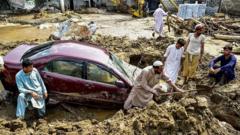In the wake of severe monsoon flooding and landslides, officials in north-west Pakistan have reported that more than 200 individuals remain missing, particularly in Buner district. The devastating torrential rains have taken the lives of more than 300 people in Pakistan and Pakistan-administered Kashmir recently, with the majority of fatalities occurring in the mountainous Khyber Pakhtunkhwa province.
According to Jehangir Khan, a spokesperson for the deputy commissioner office of Buner, at least 209 residents are still unaccounted for, and this figure could potentially rise as search efforts continue. Rescue teams have also had to bury eight unidentified bodies, as families have been unable to come forward to claim them due to the destruction of access roads.
Asfandyar Khattak, head of the provincial disaster management authority, emphasized that dozens of individuals are also missing in nearby Shangla district, complicating the overall rescue operations. The scale of the disaster is severe, with reports indicating that "10 to 12 entire villages" have been partially buried due to landslides.
The monsoon season—which typically spans from June to September—contributes to approximately three-quarters of South Asia's annual rainfall. However, recent studies indicate that climate change is intensifying the frequency and intensity of such extreme weather events. Alongside the catastrophic flooding in Pakistan, torrential rain also struck Indian-administered Kashmir, resulting in at least 60 fatalities there.
In addition to the destruction in Buner, nine lives were lost in Pakistan-administered Kashmir, while five individuals died in the northern Gilgit-Baltistan region. With forecasts predicting continued heavy rainfall until 21 August, several areas have been declared disaster zones, putting immense strain on ongoing rescue and recovery efforts.
This season, Pakistan has faced an unprecedented crisis, with official statistics indicating at least 650 deaths due to flooding since June. Punjab province, which is home to nearly half of Pakistan's population, recorded significantly higher rainfall compared to previous years, leading to concerns over increased mortality and infrastructure collapse.
Northern Pakistan is one of the most glaciated regions, but climate change has accelerated the melting of these glaciers, leading to instability in the landscape. As scientists continue to investigate the root causes of the recent floods and landslides, they suggest that glacial melt is a contributing factor, coupled with the destabilizing effects of monsoon rains on mountain terrain.


















